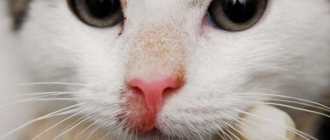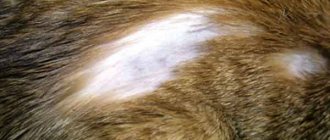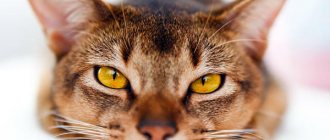Feline chlamydia: symptoms, tests, vaccination
Feline chlamydia is an infectious disease caused by the bacteria* Chlamydophila felis. They are among the pathogens* that cause the development of upper respiratory tract syndrome* in cats. The main clinical manifestations of the disease include conjunctivitis*, which is initially often unilateral and sometimes accompanied by nasal discharge. Many cats are asymptomatic* carriers of the disease. In recovered animals, the disease often recurs. In both cases, periodic release* of bacteria is observed. The disease primarily affects young cats living in communities.
These bacteria have little resistance to the external environment.
Chlamydophila felis under an electron microscope (©Merial).
Infection of cats with chlamydia
Typically, the disease develops in cats under one year of age. Weaned kittens, who lack maternal immunity, are very susceptible to this type of bacteria.
Because these pathogens are highly sensitive to the environment, transmission occurs primarily through direct contact (called nose-to-nose contact) with a cat shedding significant amounts of bacteria, such as in tears or nasal discharge.
The risk of infection is highest in stray cats that come into contact with their feral relatives, as well as in animals living in communities. Moreover, the prevalence* of the infectious disease is higher in purebred cats. In the case of group housing, the prevalence is due to the fact of chronic carriage* of chlamydia by producers and their reactivation under stress conditions (transportation, surgery, pregnancy, breastfeeding, etc.).
Chlamydia, which you should not be afraid of
These types of chlamydia in animals cannot parasitize humans because they are not genetically adapted to this. These chlamydia include:
- Chlamydia suis is the causative agent of chlamydia in pigs. This chlamydia is a very close relative of Chlamydia trachomatis. They are so similar that they were previously confused - it was believed that C. trachomatis occurs in pigs, and only later it was established that it is a separate species. Chlamydia suis is completely safe for humans.
- Chlamydia pecorum is a pathogen that causes conjunctivitis, arthritis, and inflammation of the urogenital tract. But not in people, but in cattle - pigs, goats, sheep and, interestingly, koalas, in which it provokes infertility. It poses no danger to humans.
- Chlamydia muridarum is the causative agent of chlamydia in hamsters and mice. Previously, it was also considered a subspecies of Chlamydia trachomatis, but now it is separated into an independent species, which is harmless to humans.
- Chlamydophila caviae - causes conjunctivitis and urogenital inflammation in guinea pigs, which is very similar to the symptoms of C. trachomatis in humans. In laboratory conditions, it was possible to infect mice, hamsters and rabbits with C.caviae, but in nature only guinea pigs are affected by these chlamydia. People do not get sick with chlamydia.
- Chlamydia pneumoniae (animal subspecies only!) - causes respiratory tract diseases in both humans and various animals. Transmitted by airborne droplets. But humans and animals have different strains of chlamydia pneumonia. This means that transmission of infection from an animal to a person is impossible : a person transmits only human chlamydia pneumoniae to other people, and animals only transmit “animal” chlamydia to each other.
After changes in the classification of chlamydia, scientists finally established that the subspecies Chlamydia trachomatis is a pathogen that is found only in humans and does not pose a danger to animals.
The development of chlamydia in cats
Chlamydophila felis actively reproduces at a body temperature of 35 °C. This explains the fact that bacteria multiply primarily on the conjunctiva* and secondarily on the mucous membranes* of the nasal cavity and lungs. The incubation period* ranges from three to five days.
After the first infection, the release of bacteria is usually observed within 1-2 months, even if there are no symptoms.
For some cats, the shedding period can last for years. It is because of such asymptomatic excretors* of chlamydia that the prevalence of the disease in group-kept cats is the highest.
Natural post-infectious immunity* is rather weak and short-lived, which is why relapses occur. Maternal immunity protects kittens until the age of 1-2 months.
Clinical manifestations
Conjunctivitis
Conjunctivitis, accompanied by severe lacrimation, is the main clinical sign of the disease. Often, conjunctivitis develops first on one side, and the second eye is affected only after a few days. Discharge from the tear ducts becomes purulent*, the third eyelid swells and covers part of the eye.
Unilateral conjunctivitis caused by Chlamydophila felis (© Merial).
Rhinitis
Clinical signs of rhinitis include sneezing and sometimes nasal discharge. There may be a slight increase in body temperature and decreased appetite.
The disease develops over six to eight weeks and can become chronic. Clinical recovery does not exclude carrier status*. Relapses are common.
Other forms
Chlamydophila felis was isolated from various organs (stomach, lungs, vagina). Thus, it can be assumed that these bacteria contribute to the development or cause the appearance of other clinical syndromes. It is believed that they can provoke spontaneous abortion.
Additional tests conducted and interpreted (eg PCR) by one of the veterinarians confirm the involvement of these bacteria in the observed disorders. Extreme caution must be used when interpreting laboratory results as they may require a very careful approach.
Possible complications
If the symptoms are blurred, for example, a cough, runny nose, lacrimation, then subsides or returns; chlamydia can develop into a chronic form and be asymptomatic in the cat’s body. In this case, the animal becomes dangerous for humans if you delay going to the veterinary clinic and do not follow basic hygiene rules.
The danger of chlamydia is that the blood of an animal can spread the infection throughout the body. As a result (if left untreated), organs and tissues suffer from multiple lesions against a background of weakened immunity.
In advanced cases and severe cases of the disease, the animal cannot be saved.
To prevent chlamydia in cats
Sanitary and preventive measures
The first and most important measure to prevent the development of diseases is sanitary and preventive measures (see relevant technical information).
In every case of chlamydia in cats, attention must be paid to three aspects:
- the transmission of microorganisms is direct* (see above), therefore, it is necessary to distribute animals into sectors to isolate potential carriers of bacteria (adults, patients, and animals brought into the nursery from outside) from the animals most susceptible to infection (kittens). The resulting adherence to the principle of moving only forward is also very important;
- limiting the number of cats in each specific area allows not only to reduce the level of stress (which contributes to the appearance of clinical signs), but also the level of spread of the disease if it affects one of the individuals;
- standard cleaning and disinfection of premises and hands can limit the degree of risk (negligible) of indirect transmission of pathogenic microorganisms.
Vaccination
Chlamydophila felis belong to the causative agents of diseases (determining the valence* of the vaccine), which are called variant (English: “non core”), that is, the use of a vaccine containing them is recommended in animals at risk. The veterinarian uses it when he considers it necessary, for example in infected nurseries or shelters with a high risk of infection.
In Russia, inactivated vaccines with the addition of an adjuvant* or live attenuated vaccines are available. The purpose of using these vaccines is to eliminate or significantly reduce the intensity of clinical manifestations, and in certain cases, to reduce the level of isolation* of bacteria.
Vaccinated animals may not show clinical signs of the disease, but may be a carrier of the bacteria: an animal that is vaccinated and protected (that is, will never show clinical signs) can be a carrier of the bacteria
Purevax RCPCh is used to protect kittens and cats from chlamydia. Vaccination schedule for kittens against chlamydia.
What to do at home
Like other cat diseases, chlamydia is treated in strict accordance with the veterinarian's instructions. If the infectious condition is not aggravated by pneumonia and difficulty breathing, then treatment can be carried out at home.
During this period, the pet must be isolated from other animals. The course of prescribed therapy, despite the improvement in the cat’s health, is carried out to the end. This takes approximately a month and allows you to exclude a recurrence of the disease, which can occur if the infection persists in the animal’s untreated body.
You should carefully monitor the hygiene of a sick cat:
- wet cleaning of the area where the cat is located with disinfectants;
- clean the toilet more often;
- Wash the food plate thoroughly immediately after eating.
In order for the prescribed treatment to bring a positive result, the owner must follow all the prescriptions and recommendations of the veterinarian.
Fermented milk products should be included in the diet. You should pay attention to vitamins and minerals to restore the animal’s strength. No special diet is required for this disease.
Main characteristics of feline chlamydia
- Chlamydophila felis is a bacteria.
- They multiply mainly in the cells of the mucous membrane* of the conjunctiva.
- Most animals become ill before one year of age.
- Transmission of the disease occurs directly* through direct contact with eye secretions from infected cats, regardless of whether they themselves are sick.
- In cats living in communities, as well as in nurseries, the disease is more common compared to cats that are the only pets of their owners.
- Conjunctivitis first develops on one side, then becomes bilateral. Discharge* from the eyes is initially liquid, but later becomes mucopurulent*.
- Standard sanitary and preventive measures can reduce the risk of developing chlamydia.
MisterCat recommends: kitten treatment
Treatment for chlamydial infection in kittens differs from that for adults. This is due to the characteristics of a young body. Tetracycline antibiotics in kittens cause tooth decay, damage to the gastric mucosa, and lead to improper formation of the nail plates. The drugs of choice in this case are:
- Clavil;
- Sinulox;
- Amoxicillin.
The further treatment algorithm is the same as for adults. Eye ointments, drops and immunostimulants are used.
Sick kittens are isolated, and the cat is taken to a veterinary clinic for diagnosis and treatment for chlamydial infection. In addition, it is necessary to examine a cat that has had sexual contact with a sick female.
Glossary of terms
- Adjuvants: Substances that direct and enhance the immune response to the pathogen that the vaccine is used to combat.
- Pathogenic microorganism (microbe): a microorganism capable of causing disease in the organism it infects (examples: virus, bacterium, fungus, etc.).
- Asymptomatic: having no clinical manifestations.
- Bacteria: A living microscopic organism consisting of a single cell. Bacteria can be pathogenic, harmless, or beneficial to the body.
- Conjunctiva: membrane lining the inner surface of the eyelids. This membrane secretes mucus (fluid) that moisturizes the surface of the eye.
- Conjunctivitis: inflammation of the conjunctiva.
- Upper respiratory tract syndrome : a disease that can be caused by a number of viruses (in particular herpesvirus and calicivirus) and numerous bacteria (Chlamydophila felis, Bordetella bronchiseptica, Pasteurella multocida...). It is manifested by the development of conjunctivitis, the appearance of liquid and then thick discharge from the eyes and nose, sneezing, and damage to the oral cavity. May cause deterioration in the general condition of the body (feverish state, anorexia). The severity of clinical manifestations depends on the pathogenic microorganisms that cause them.
- Asymptomatic pathogen excretor: an animal that has no symptoms of disease, but pathogenic microorganisms in the body multiply and are then released into the external environment. Such an animal can therefore be infectious. This phenomenon is often observed, for example, in carriers of calicivirus or feline herpesvirus.
- Excretion (of a pathogenic microorganism): the release of a pathogenic microorganism from the body into the external environment. This phenomenon underlies the process of transmission of pathogens of infectious diseases from one animal to another.
- Incubation period: the time interval between the penetration of a pathogenic microorganism into the body and the appearance of clinical signs.
- Post-infectious immunity: a state of body defense formed as a result of infection with a pathogenic microorganism.
- Mucosa: moist tissue that lines cavities that open to the external environment (for example, the gastrointestinal tract, respiratory, urinary and reproductive tracts, etc.).
- Edema: swelling of a tissue or organ caused by excess fluid in the intercellular space.
- Pathogen : See pathogenic microorganism.
- Pathogenesis: mechanisms of occurrence and development of diseases.
- Carriage: the presence and, in some cases, reproduction of pathogenic microorganisms in the body of an animal, in the absence of corresponding symptoms. The frequency of occurrence of this phenomenon is high.
- Asymptomatic carrier of pathogens: an animal in which there are no symptoms, but the pathogen is present in the body and, in some cases, multiplies.
- Prevalence: The number or percentage of animals affected by the disease.
- Purulent: containing pus, synonymous with infection.
- Rhinitis: inflammation of the nasal mucosa (see this term).
- Direct transmission : transmission of a pathogen by direct contact between two individuals. It is this type of transmission that is characteristic of most unstable pathogenic microorganisms in the external environment.
- Ulcer: an open wound that is difficult to heal (for example, skin, mucous membranes, cornea, etc.). It contributes to the spread of superinfections caused by bacteria.
- Vaccine: a drug intended to form protection in an animal against the expected effects of a pathogenic microorganism, contact with which is possible in the future.
- Vaccine Valency: The “part” of a vaccine that protects against a specific pathogen. A vaccine can be monovalent (protect against one disease) or polyvalent (protect against several diseases).
Can it be transmitted to humans?
It is almost impossible to become infected with chlamydia from a cat. People with weak immune systems are at risk; the infection usually affects the eyes.
If infection has already occurred, chlamydia will lead to diseases of the eyes and respiratory tract.











